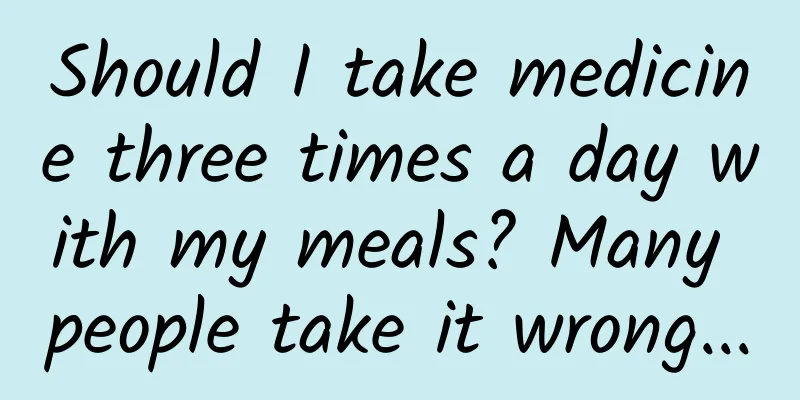Should I take medicine three times a day with my meals? Many people take it wrong...

|
When we take medicine, we often see "three times a day" written on the instructions. Many people will take it once in the morning, noon, and evening when eating. But in fact, most of the three times a day medication has nothing to do with meals. Let's start from the beginning about the frequency of taking medicine every day. Once a day Let's talk about once a day. It means taking it once a day at the same time. The "same time" is important. For example, every morning or evening. Some drugs have a prescribed time for taking the drug in the instructions, which shall prevail. For example, dexamethasone or prednisone should be taken after a meal in the morning to increase efficacy and reduce side effects. Twice daily If the usage indicates twice a day, it means once in the morning and once in the evening, about 12 hours apart, such as cefuroxime. Copyright images in the gallery. Reprinting and using them may lead to copyright disputes. Three times a day Now to the point. The most common misunderstanding is that three times a day means taking the drug once a day, in the morning, at noon and at night. Note that this is not breakfast, lunch or dinner. This refers to an interval of about 8 hours, which is defined by dividing 24 hours a day by three times. If we follow the time of three meals, then the time between dinner and breakfast the next morning is too long, which will affect the stability of the drug concentration in the body. For example, for antibacterial drugs, anti-epileptic drugs, drugs for treating parkinsonism, antihypertensive drugs, etc. that require high blood drug concentration stability, the efficacy may be seriously affected. The time between breakfast and lunch, or lunch and dinner, must be less than eight hours, which may cause high drug concentrations and increase the risk of adverse reactions. What's more, our meal times may not be regular. In any case, it is not rigorous to use meals to calculate the time to take medicine. If it is difficult to strictly take the medicine every 8 hours, for example, if the child sleeps for a long time, there is no need to wake up the sleeping child to take the medicine. For example, for oral antibiotics, a difference of two hours is not a big problem. Just make the intervals between taking the medicine as balanced as possible. Once every three meals In addition, nothing is absolute. The time to take some medicines is really related to the time of three meals, such as hypoglycemic drugs and drugs for treating the digestive system. Since the level of blood sugar or gastric acid is related to eating, these two types of medicines should be taken with the time of three meals, not every 8 hours. But this is a minority after all, and there will be special marks in the instructions. For other medicines that do not emphasize taking them at the same time as meals and require taking them three times a day, try to take them every eight hours. Copyright images in the gallery. Reprinting and using them may lead to copyright disputes. Other situations After understanding the most difficult part, “three times a day”, the rest will be easy to understand. Let’s continue. Four times a day, according to the previous idea, it means taking the medicine once every 6 hours, such as 7 o'clock, 13 o'clock, and 18 o'clock. It is similar before going to bed. It also depends on the specific work and rest time. If the sleep time is very long, you may need to wake up in the middle to take the medicine. Regarding the interval between medications, most medications are based on their half-life in the body. Some medications need to maintain a stable concentration, so they need to be taken at fixed times, such as Parkinson's medications that need to be taken every 8 hours, and some medications that need to be taken every 12 hours. But some drugs just remind everyone that the time interval should not be less than the prescribed time interval. For example, acetaminophen requires 4-6 hours between two doses. After we took it, the fever-reducing effect was good, but the fever did not come back until 12 hours later. We can also wait 12 hours before taking the second dose. If the fever does not come back later, you can stop taking the medicine at any time. It is not necessary to take the medicine according to the intervals in the instructions. This type of medicine is taken on demand. To put it bluntly, you can take it when you need it, and don't take it when you don't need it. In short, don't be careless about medication. Whether it is the time to take the medication or the method of taking the medication, it is safer to read the instructions several times. If you really have questions, then ask a professional! Planning and production Author: Liu Ziqi, Chief Pharmacist, First Affiliated Hospital of Harbin Medical University Reviewer: Tang Qin, Director of the Science Popularization Department of the Chinese Medical Association, National Health Science Popularization Expert |
<<: A supportive life can also be a wonderful life!
>>: What happens to your brain when you walk? The benefits are beyond your imagination!
Recommend
What does caesarean section mean?
Although the term cesarean section is becoming mo...
Causes of abdominal pain in women
We all know that the biggest problem threatening ...
Can I drink alcohol during my period?
If you have your period, you must not drink alcoh...
Why does a lady have back pain?
Women's health can be easily manifested in va...
Have you been persuaded to drink during the Chinese New Year? This type of people who drink have a higher risk of cancer
During the Spring Festival Friends and family gat...
Lettuce Wraps Grilled Meat: What Should We Watch Out For?
When enjoying food at a barbecue restaurant, many...
How can I treat the fishy smell down there myself?
Women often find that there is a fishy smell down...
What causes bleeding after sex?
Sexual intercourse is a common behavior in modern...
Benefits of cervical erosion ablation surgery
Gynecological diseases can cause great harm to wo...
Can I eat Zongzi during breastfeeding?
Eating a lot of rice dumplings during the Dragon ...
The harm of women sleeping on their backs
Good sleep is the guarantee for efficient work th...
How to increase your chances of pregnancy
There is a probability in doing anything. After a...
What are the causes of bacterial vaginosis?
In daily life, many women gradually suffer from g...
Age of epiphyseal closure in girls
Many of our friends may have experienced some emb...
When oxytocin was stopped, the contractions also stopped.
Many pregnant women do not show any signs of givi...









